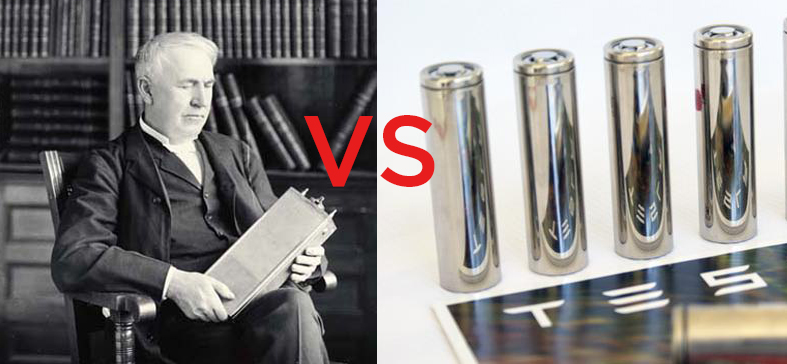I get asked a fair amount via email and other communications why I don’t use NiFe batteries or if there are any advantages to using them over the lithium-ion EV batteries that I use. My current view is that NiFe batteries provide almost no extra benefits for a lot of extra downsides, as I go over in great detail within the solar basics course, the current crop of commercially available lithium-ion packs already have very good life cycles (exceeding 8-10 years) especially when used in the lower demand use of solar. I would also be quick to point out that lifetime number is based on the point at which the batteries capacity reaches 80% of original, they will still continue to work after that point, you will just have less usable capacity (but that may not be such a big deal for use in a home).
Some of the major downsides to NiFe include:
Low specific energy (which ties into space and weight constraints)
NiFe has a specific energy of about 20Wh/kg, which is very low compared to most lithium packs today, which meet or exceed 150Wh/kg, meaning more usable energy per kg. Because of this low specific energy gotcha, it will take a large amount of space to have any significant amount of energy storage (the average large American home uses ~30kWh/day). For a case example,
Low cycle efficiency
NiFe “boasts” a charge/discharge efficiency of less than 65%, meaning you have to put a lot more energy in to fill them up, but you don’t get any of that back out during discharge. Example, assuming you had to charge a 10kWh battery you would need 10kWh x 1.538 = 15.38kWh but you don’t get that extra 5kWh back out during usage since it’s lost in the inefficiency of the electrochemical reactions. Li-ion, on the other hand, is somewhere around 80-90%, meaning it would only take 12.5kWh to charge that same 10kWh battery (on the worst end).
High self-discharge rate
NiFe comes in at roughly 20-30% per month vs. Li-ion at only 2%/month. This once again means you need to collect even more energy (and waste 35% in the charging process alone) just to keep your batteries above water (no pun intended). If your supply of electricity was cheap and bountiful then this wouldn’t be such a big issue, but as it stands, solar panels are not free (though they are cheaper than ever), so having to buy more just to waste the power they produce on inefficient batteries seems a shame.
Maintenance
Just like flooded lead-acid batteries, NiFe requires frequent water+electrolyte refilling, while not rocket science, it’s one more thing to manage. If peoples furnace or car intake filters are any indications of diligence when it comes to regular and routine maintenance, then I don’t have hope for people refilling their batteries on a prescribed schedule to exacting amounts. This “small detail” also rarely gets mentioned in any sales literature bragging about the supposed “50-100 year” lifetime of NiFe, I can guarantee you that the water in your batteries now will not still be left in 2068. While water is cheap (also for the moment) it’s a continuing monetary and time cost which lithium does not have.
Cost
Finally, what I see as the biggest issue, cost. NiFe clocks in at over $800/kWh (meaning $18.4k for a 23kWh pack) if you buy from Iron-Edison (one of the more popular companies that sells them). Even today’s “expensive” Li-ion batteries are already under $250/kWh with prices rapidly falling as electric vehicles are becoming more popular. Given that there is no volume user for NiFe (because of all the downsides listed) it means you don’t get the advantage of large economies of scale, which help to lower cost (the more of something we make, the better and cheaper we are able to make it) this is just one of the major benefits that Li-ion has going for it.
Given all of the above, I just can’t honestly recommend them to anybody for most uses (especially off-grid storage). Despite the magical claims of 100yr lifetimes and rugged performance I see all over the internet (to be taken with a hefty salt shaker) the adage “if it sounds too good to be true…it probably is” applies as much to batteries as it does everything else in life.

